A quartz crystal microbalance (QCM) is a device that measures changes in the resonant frequency of the quartz crystal as a result of the binding of molecules to its surface. The sensitivity is in the ng to μg range. QCM sensors are coated with a metal, often gold, that serves as an electrode for electrical connection, and can be functionalized with an immobilized ligand. Binding between an analyte in solution passing over the sensor surface and a ligand is detected as a drop in resonance frequency. MOSBRI‘s reference site for QCM, NIC, has experience using protein A as a ligand for sensitive detection of IgGs. Other applications can be developed. Please contact NIC if you have ideas for functionalization.
What are the sample requirements?
- The solution does not need to be extremely pure as the binding to the ligand is specific to the analyte.
- The binding interaction between the protein A ligand and an IgG analyte has been demonstrated at concentrations as low as 3 ug/ml.
- The working volume is approximately 15 μl.
What other specific considerations are relevant?
- In general, the solution is passed over both a non-functionalized and a functionalized QCM crystal to distinguish binding of the analyte from non-specific binding of molecules to the sensor.
- Once the ligands are saturated with the analyte, a regeneration step is required.
Partners offering this technique
MOSBRI reference partner site for this technique:
Other partners:
